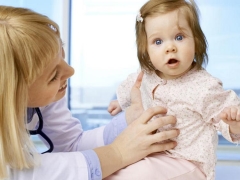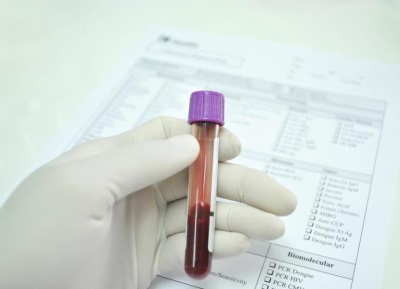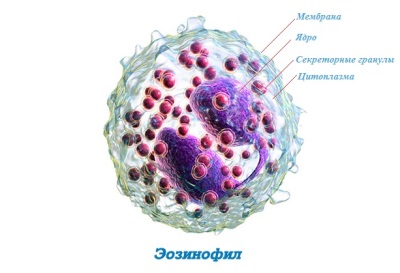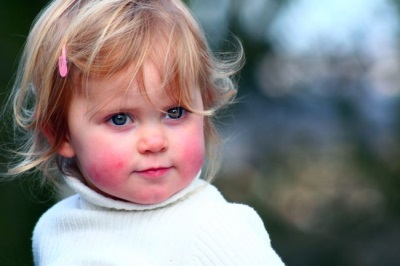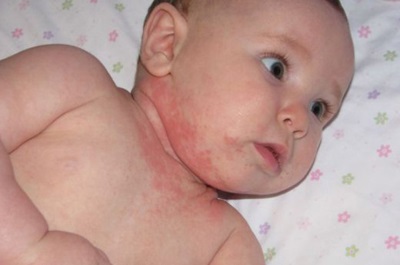Elevated eosinophils in the blood of a child
When at least one of the indicators in the analysis of a child’s blood is elevated, it is always alarming for parents. Especially when it comes to one of the types of white blood cells, because many mothers know that these cells are on guard for the child’s immunity. This means that their increased number may signal that a son or daughter has some kind of health problem. Why does the child have an increase in the number of eosinophils and what actions of parents will be correct with such changes in the blood test?
Why do we need eosinophils
Eosinophils are called one of the types of white blood cells, which are blood cells. Due to the presence of granules inside such cells, they are referred to granulocytes together with other types of white blood cells (basophils and neutrophils). The main function of these leukocytes is the protection of the child’s body from exposure to various allergens and toxins, as well as pathogens of parasitic, staphylococcal and other infections. In addition, these cells regulate the inflammatory process.
Eosinophils are formed in the bone marrow, like other blood cells, and after entering the bloodstream they are either in the capillaries or in different tissues of the body (in the respiratory tract, skin, intestinal cells and other places). In the peripheral blood, they are determined in relatively small quantities. An interesting feature of such cells is that eosinophils can actively move using the amebioid method. So they "fit" to the desired infectious agent or toxin that needs to be neutralized.
At the same time, these white blood cells are able to absorb both the foreign particles themselves and the immune complexes formed in the child’s body or histamine. When exposed to parasites, eosinophils secrete enzymes that destroy their membrane. In addition, eosinophilic leukocytes secrete prostaglandins and other biologically active compounds.
What level of eosinophils is elevated
The rate of eosinophils is determined in a blood test by counting leukocyte counts. The level of such cells is expressed as a percentage of the total number of white cells.
The upper limit of the norm for children is:
- Not more than 5% of eosinophils up to the age of one (in newborns up to the 10th day of life, the upper limit will be 4%).
- Not more than 4% of eosinophils in children who are already 1 year old.
If eosinophils are elevated in a child’s blood, this condition is called eosinophilia. It is reactive (small) when the level of these leukocytes rises to a maximum of 15%. Moderate eosinophilia is also isolated if this type of leukocyte is 15-20% of all white blood cells. With an indicator of more than 20%, they speak of high eosinophilia. In some children with an active pathological process, eosinophils represent 50% of all leukocytes or even more.
Causes of eosinophilia
The most common causes of the excess of the normal percentage of eosinophils in childhood are allergic reactions and helminthic invasions. When they are present, the child is detected predominantly reactive eosinophilia, that is, the rate rarely exceeds 10-15%.
Allergies today are very common pathologies in children. They can be provoked by allergenic substances from food, household chemicals, animal dander, plant pollen and other things. With Quincke, hives, exudative diathesis, bronchial asthma and neurodermatitis, the level of eosinophils always increases.
Worms are also a very common problem in children, since many babies do not fully comply with hygienic rules - they do not wash their hands or wash them thoroughly, eat unwashed vegetables, communicate with animals. All these factors increase the risk of infection with helminths, among which the most common in children are called roundworm and pinworms.
High levels of eosinophilic leukocytes are also detected when:
- Magnesium deficiency.
- Leukemia and other benign or malignant tumors.
- Polycythemia.
- Rheumatism and systemic diseases.
- Infections caused by protozoa.
- Infectious mononucleosis.
- Malaria.
- Scarlet fever and other acute infections caused by bacteria.
- Dermatitis, psoriasis and other skin diseases.
- Vasculitis
- Tuberculosis.
- Immunodeficiency.
- Burns occupying a large area of the body.
- Lung Disease
- Reduced thyroid function.
- Cirrhosis of the liver.
- Congenital heart defects.
- Removal of the spleen.
- Taking certain medications, such as sulfonamides, nitrofurans, hormones or antibiotics.
- Enhance vagus nerve tone.
Separately allocated eosinophilia, which is caused by a genetic factor. In addition, an increased number of eosinophils can be detected in children who have recently had pneumonia or hepatitis. After such diseases, as in the postoperative period and after injuries, eosinophilic leukocytes can be determined above the norm for quite a long time.
Symptoms
If a child has eosinophilia, this condition does not manifest specific symptoms, but will have a clinical picture of the underlying disease that provoked a change in leukogram. A child may have high fever, anemia, enlarged liver, heart failure, joint pain, weight loss, muscle pain, skin rashes, and other symptoms.
In allergic diseases there will be complaints of itchy skin, dry cough, dermatitis, rhinitis, and other signs of allergic reactions. If the cause of eosinophilia is roundworm or pinworm, the child has a disturbed sleep, itching in the anus and genitals, and the appetite and body weight change.
What to do
Finding in the analysis of the child increased eosinophils, you should contact your doctor. The pediatrician will examine the child and refer it for re-analysis to eliminate the possibility of an erroneous result. Also, if necessary, will be assigned to other studies - urinalysis, coprogram, biochemical analysis of blood, check feces on helminth eggs, serological tests and so on.
Treatment for eosinophilia should be directed to the cause of such a change in blood.
The doctor will take into account the main disease and prescribe the desired course of treatment:
- When infected with pinworms, ascaris or other parasites, the therapy will be aimed at the destruction of such pathogens and their removal from the children's body.
- Having identified an allergic disease in a child, first of all, they establish allergens that caused it and cause exacerbations. Also, the child is prescribed antihistamines to relieve itching and inflammation.
- If high eosinophils are provoked by previously prescribed drugs, they are canceled.
As soon as the child's general condition improves, and the symptoms of the disease that caused high eosinophils disappear, the leukocyte formula also normalizes.
You can learn more about eosinophils by watching the following video.
